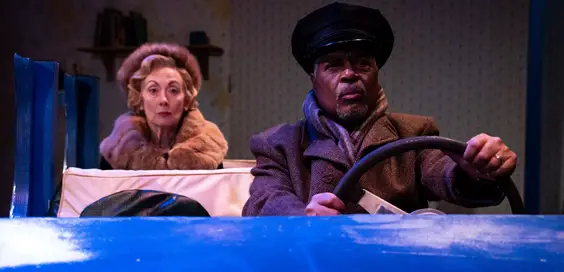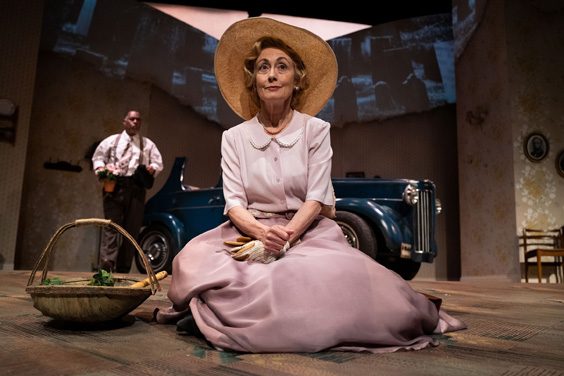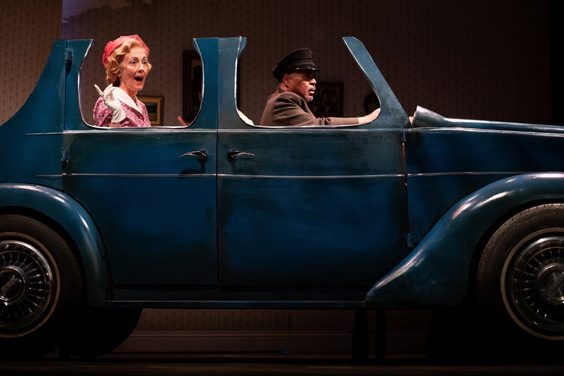Driving Miss Daisy – Review – York Theatre Royal

By Gail Schuster, June 2019
The period of history spanned by Driving Miss Daisy illustrates how long a culture of tolerance can take to develop and how easily it could be lost. Indeed, recent events would seem to confirm that it is still an ongoing process. Whilst on the surface the story is of the enduring relationship between an elderly lady and her long term driver against the backdrop of the emerging civil rights movement in America, it’s a great vehicle for “The process of delicate social exchanges between white and black, woman and man, Jew and Christian, boss and employee, elderly and caregiver and finally friend to friend,” explains Director Suzann McLean.
Paula Wilcox, famous for her roles in Man about the House, Upstart Crow and Living the Dream amongst others, plays the elderly Miss Daisy with skill and a sympathetic, light touch. Following a car accident at 72 she is unwillingly coerced by her son, Boolie (Cory English) to take an African American driver. The part of Hoke, her chauffeur, is played by multi-talented Maurey Richards, a member of the singing group The Platters for 10 years. His employer makes her reluctance clear by refusing to be driven anywhere for the first six days, about which he wryly observes to her son, “It only took six days; the same time it took the good Lord to make the world.”
“Cleverly realised”
As the title would suggest, much of the performance takes place in the cars owned by Miss Daisy and driven by Hoke. The car itself is cleverly realised by using a half vehicle, mounted on a revolving central point, which then rotates providing both a feeling of movement and the opportunity for the audience to see the interior and the actors inside. The car has such a central role that at the end of the production, it gets to acknowledge the applause from the audience.
The remorseless passage of time and the dramatic historic events that take place are presented to the audience via popular media images at the top of the scenery. These start as newspaper articles and move through radio, black and white television to colour. In one very effective scene, Hoke and Miss Daisy are marooned in a traffic jam caused by the bombing of the local Jewish temple. Her naivety of religious difference is illustrated by her surprise at the attack: “I am sure they meant to bomb one of the conservative synagogues… The synagogue is reform.” Hoke gently points out that to the people perpetrating this crime there is no difference: “A Jew is a Jew, Miss Daisy.”
“Warmth”
The playwright, Alfred Uhry, based the story on his own memories of his grandmother and the driver who drove for her for 25 years. Many aspects of Uhry’s own life are brought up in the show: “Everyone thinks Jews are all the same, but we didn’t think so in the South. The way I was brought up, the best thing to be was Episcopalian. In our temple the music was Christmas hymns. I was brought up with Christmas trees, Easter egg hunts – and my Jewish face.” Indeed, on a visit to her son Boolie’s house, Miss Daisy and Hoke discuss the Christmas decorations, put up outside by her daughter-in-law. Uhry received an Outer Critics Circle Award and the Pulitzer Prize for Driving Miss Daisy and when in 1989, it was made into an Academy Award winning film (Best Picture of the Year), he won the Oscar for screenplay adaptation.
The performance progresses sedately, like the main characters, but with warmth. They are comfortable with each other’s foibles and live in their own small world, getting on with their routines but from time to time, events in the outside world intrude. The gradually changing nature of the relationship between Hoke and Miss Daisy, however, is never acknowledged by either of them. The audience clearly appreciated the performance and Wilcox looked visibly touched at the end.
Driving Miss Daisy is a well observed mix of gentle humour and poignancy as both characters become firm friends, slowly growing older together. It underlines that the best way to overcome lack of diversity and intolerance is through familiarity and understanding, rather than segregation.
images: Sam Taylor











